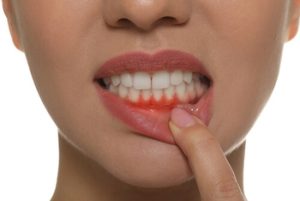To maintain optimal oral health, being vigilant and identifying early signs of dental issues is essential. One of the most common and concerning problems is the tooth abscess. But what does a tooth abscess look like? Let’s dive deep into understanding this dental condition and how to address it.
Understanding a Tooth Abscess: A Deeper Insight
A tooth abscess, colloquially known as a dental abscess, stands out as a particularly concerning dental ailment. At its core, an abscess is a pocket filled with pus stemming from a bacterial infection. This unseemly pocket can arise in diverse tooth sections, with the causative factors spanning tooth decay, gum diseases, or traumatic tooth injuries. Given the varying locales of its manifestation – it could be deep-rooted within the gum tissue or visibly evident near the tooth root – it’s crucial to comprehend its intricacies to facilitate prompt action.
Pinpointing a Tooth Abscess: Key Indicators
 Physical Manifestations
Physical Manifestations
On initial observation, a dental abscess showcases as a prominent swelling or bump on the gum, oozing with a thick, yellowish liquid known as pus. Sometimes, the abscess might play elusive, hidden deep within the gum’s sanctum or nestled close to the tooth root, rendering it invisible to the naked eye.
Experiencing Pain and Discomfort
The signature trait of a tooth abscess is an unrelenting, severe pain. This isn’t your run-of-the-mill toothache. It’s a pulsating, intense agony that can waltz to the upper or lower jaw, even reaching as far as the neck or ear. Such tooth pain is more than just a symptom – it’s a distress signal demanding attention.
Additional Warning Signs
Besides the characteristic pain, there’s a suite of tooth abscess symptoms. These can encompass a sudden spike in body temperature (fever), pronounced swelling of the face, an unpleasant taste akin to having ingested something foul, and heightened sensitivity to temperature extremities in food. Should the abscess rupture, the mouth might be inundated with a foul-tasting liquid, compounding the distress.
Unravelling the Causes Behind Tooth Abscesses
The Ravages of Tooth Decay
Tooth decay stands tall as a primary offender. As bacteria orchestrate an invasion of the teeth and gums, they carve a path through the protective tooth enamel, delving deeper into the dentin and, eventually, the pulp. This bacterial siege lays the groundwork for an infection, culminating in an abscess.
The Scourge of Gum Disease
Termed medically as periodontal disease, gum disease is the unsavoury outcome of neglecting oral hygiene. This condition paves the way for ‘periodontal pockets’ – small spaces between the teeth and gums. These pockets become fertile grounds for bacteria to thrive and multiply, potentially leading to a gum or periodontal abscess.
Traumas and Injuries
A mere chipped or fractured tooth can be a gateway for bacteria. Such physical aberrations can inadvertently welcome bacteria, culminating in an infection.
Dental Abscess Variants
Periapical Abscess: A periapical abscess, characteristically forming at the pinnacle of a tooth’s root, commonly originates from dental decay that has stealthily progressed into the pulp chamber.
Periodontal Abscess: Strategically positioned in the gum adjacent to the tooth root, this abscess variant frequently traces its origins to gum diseases or physical trauma.
Gingival Abscess: Exclusively forming in the gum tissue, a gingival abscess remains isolated from the tooth or the surrounding periodontal ligament.
Emergency Dentistry for Tooth Abscesses
When it comes to dental dilemmas, a tooth abscess tops the list in terms of discomfort and potential health implications. Given its acute nature, emergency dentistry often becomes the need of the hour. Let’s delve into how emergency dental care responds to this pressing issue.
 Immediate Assessment and Diagnosis
Immediate Assessment and Diagnosis
In an emergency setting, the first step is a thorough assessment. An abscessed tooth is not just a result of tooth decay or gum disease; it signifies a bacterial invasion deep into the inner sanctum of the tooth or gums.
The dentist usually begins with a visual examination, followed by dental X-rays. These images are crucial to determine the extent of the abscess and to assess if the infection has spread to adjacent teeth or the surrounding bone.
Incision and Drainage
For immediate relief, especially in cases where the pain is unbearable, a dentist might opt to drain the abscess. This involves making a small incision into the abscess to let the pus out. It’s a swift procedure and offers almost instantaneous respite from the throbbing pain associated with the pocket of pus. The area is then cleaned meticulously to ensure no remnants of the infection linger.
Root Canal Therapy
Often, the route to treating a tooth abscess leads to a root canal, especially if the cause is an infection deep within the tooth’s pulp. Root canal treatment involves infected pulp removal, cleaning and disinfecting the tooth cavity, and then filling and sealing the space. This procedure not only addresses the abscess but also saves the tooth, preventing the need for extraction.
Antibiotics
If there’s a concern that the infection might spread to other parts of the mouth or even to the neck or other regions, antibiotics might be prescribed. While they won’t treat the abscess per se, they’ll curb the spread of the bacterial infection.
Tooth Extraction
Extraction might be the most viable option when the tooth is extensively damaged and cannot be salvaged. Emergency dentists prioritise saving the tooth, but sometimes, the damage is too profound. After extraction, once the healing process is complete, there are several restorative options like dental implants or bridges to consider.
Prevention is Better Than Cure: Safeguarding Your Oral Fortress
“Prevention is better than cure.” This wisdom holds particularly true for dental health, where proactive measures can deter detrimental conditions such as tooth abscesses.
Upholding Stellar Oral Hygiene
Your daily oral care routine is your frontline defence against most dental complications:
- Brushing Mastery: Engage in thorough brushing at least twice a day. Using fluoride toothpaste ensures cleaner teeth and reinforces the enamel, providing an added shield against bacterial invasions.
- The Flossing Ritual: Dental floss should be an indispensable part of your dental arsenal. It reaches the crevices between teeth, regions often neglected by a toothbrush, ensuring comprehensive cleanliness.
- Mouthwash Rinse: Conclude your oral hygiene ritual with a swish of antimicrobial or fluoride mouthwash. This refreshes the breath and combats lurking bacteria, reducing the risk of dental abscesses.
Commitment to Regular Dental Surveillance
- Consistent Dental Visits: Merely brushing and flossing aren’t enough. Ensure you pay for your dentist’s routine visits. Such check-ups can spotlight potential threats like early tooth decay or burgeoning gum diseases, nipping them in the bud.
Dietary Vigilance
- Sugar Watch: Indulging in sugary delights might satiate your taste buds, but they’re a feast for harmful bacteria. Such bacteria flourish on sugar, producing acids that attack tooth enamel, paving the way for tooth decay. Moderation is key.
Armouring Your Teeth
- Mouthguard Mandate: Wearing a mouthguard is non-negotiable for those engaging in contact sports or activities with potential dental hazards. It acts as a protective barrier, cushioning against impacts that could lead to injuries and subsequent abscesses.
Potential Repercussions of Neglecting a Tooth Abscess
Overlooking a tooth abscess isn’t just a dental oversight; it’s a potential health hazard with ramifications extending beyond the oral cavity:
Bone Deterioration: An unchecked bacterial infection from the abscess can meander to the bone anchoring the tooth. This can result in bone degeneration, compromising the very foundation of the affected tooth.
Emergence of Dental Cysts: A lingering abscess can escalate to form a dental cyst. This cyst, often manifesting at the root’s base, can further exacerbate dental complications.
The onset of Facial Cellulitis: The malevolent bacteria from an untreated abscess aren’t content to stay localised. They can journey to the facial skin, culminating in facial cellulitis – a painful, swollen, and reddened skin condition that demands immediate medical attention.
Sinusitis Siege: An abscessed upper rear tooth can become the ground zero for a sinus infection. Given the proximity of the upper teeth to the sinuses, bacterial transfer is feasible, leading to sinusitis characterised by nasal congestion, facial pain, and a persistent cough.
Graver Health Threats: While rare, the stakes with an untreated abscess can skyrocket. If given free rein, the bacteria can enter the bloodstream, potentially triggering sepsis. This is an alarmingly severe condition where the body’s response to infection wreaks havoc on its tissues and organs, mandating urgent medical intervention.
Recognising Risk Factors and Enhancing Awareness
Awareness of the potential triggers and vulnerabilities associated with tooth abscesses can play a pivotal role in prevention. While anyone can develop a dental abscess, certain conditions and practices can elevate the risk.
Past Dental Work
If not executed proficiently, past dental procedures or treatments might leave your teeth vulnerable. For instance, an inadequately filled cavity could provide an aperture for bacteria to increase, leading to a dental abscess.
History of Dental Diseases
Individuals with a bout of dental diseases, especially cavities (tooth decay) or periodontal disease, are at an augmented risk. The very existence of these conditions is indicative of regions in the oral cavity where bacteria have previously thrived.
Impaired Immune System
The immune system is our body’s sentry against foreign invaders, including harmful bacteria. Those with weakened immune systems – whether due to medical conditions, certain medications, or lifestyle choices – are inherently more susceptible to infections, including oral cavity infections.
Tobacco Use
Regardless of its form, tobacco is a sworn enemy of oral health. Whether they smoke or chew, regular tobacco users are at a higher risk of dental abscesses. Tobacco impedes the mouth’s ability to stave off bacteria, making the environment conducive for bacterial growth and invasion.
 Poor Hydration and Dry Mouth
Poor Hydration and Dry Mouth
Saliva plays a rather unsung yet pivotal role in oral health. It is a natural cleanser, washing away food particles and curbing bacterial growth. Individuals who suffer from chronic dry mouth, medically termed xerostomia, lack the protective benefits of adequate saliva, making them prime candidates for dental complications, including abscesses.
To Conclude
In conclusion, understanding what a tooth abscess looks like and its associated symptoms can be a lifesaver. Prompt detection and treatment can prevent further complications and ensure teeth and gum health.
Are you worried about a potential dental abscess or other oral health concerns? Don’t wait; contact us now and set an appointment by calling (08) 7078 8263. Your dental health is paramount.
Note: Any surgical or invasive procedure carries risks. Before proceeding, you should seek a second opinion from an appropriately qualified health practitioner.
References:
https://www.aae.org/patients/dental-symptoms/abscessed-teeth/




